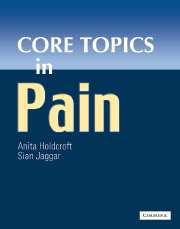Book contents
- Frontmatter
- Contents
- Contributors
- Preface
- Acknowledgements
- Foreword
- General abbreviations
- Basic science abbreviations
- PART 1 BASIC SCIENCE
- PART 2 PAIN ASSESSMENT
- Section 2a Pain measurement
- Section 2b Diagnostic strategies
- PART 3 PAIN IN THE CLINICAL SETTING
- Section 3a Clinical presentations
- Section 3b Pain syndromes
- 19 Myofascial/musculoskeletal pain
- 20 Neuropathic pain
- 21 Visceral nociception and pain
- 22 The management of low back pain
- 23 Cancer pain
- 24 Post-operative pain
- 25 Complex regional pain syndrome
- 26 Uncommon pain syndromes
- 27 Pain in children
- 28 Pain in the elderly
- 29 Gender and pain
- PART 4 THE ROLE OF EVIDENCE IN PAIN MANAGEMENT
- PART 5 TREATMENT OF PAIN
- Section 5a General Principles
- Section 5b Physical treatments
- Section 5c Pharmacology
- Section 5d Psychosocial
- PART 6 SUMMARIES
- Glossary
- Index
19 - Myofascial/musculoskeletal pain
from Section 3b - Pain syndromes
Published online by Cambridge University Press: 10 December 2009
- Frontmatter
- Contents
- Contributors
- Preface
- Acknowledgements
- Foreword
- General abbreviations
- Basic science abbreviations
- PART 1 BASIC SCIENCE
- PART 2 PAIN ASSESSMENT
- Section 2a Pain measurement
- Section 2b Diagnostic strategies
- PART 3 PAIN IN THE CLINICAL SETTING
- Section 3a Clinical presentations
- Section 3b Pain syndromes
- 19 Myofascial/musculoskeletal pain
- 20 Neuropathic pain
- 21 Visceral nociception and pain
- 22 The management of low back pain
- 23 Cancer pain
- 24 Post-operative pain
- 25 Complex regional pain syndrome
- 26 Uncommon pain syndromes
- 27 Pain in children
- 28 Pain in the elderly
- 29 Gender and pain
- PART 4 THE ROLE OF EVIDENCE IN PAIN MANAGEMENT
- PART 5 TREATMENT OF PAIN
- Section 5a General Principles
- Section 5b Physical treatments
- Section 5c Pharmacology
- Section 5d Psychosocial
- PART 6 SUMMARIES
- Glossary
- Index
Summary
Neural mechanisms of muscle pain
Action potentials originating from nociceptors carry information about noxious stimuli, but the perception of pain from muscles is the end product of information processing in the central nervous system (CNS).
Nociceptors
In skeletal muscles, there are three types of nociceptors that encode the intensity of noxious stimuli:
(a) Specific mechanical nociceptors responding only to high-intensity stimuli.
(b) Polymodal nociceptors encoding innocuous and nociceptive, mechanical and chemical stimuli.
(c) The free nerve endings in muscle tissue concentrated around small arterioles and capillaries between the muscle fibres and not activated by normal muscle movement or increasing muscle tension.
As in other tissues, nociceptor information in muscles is transduced and carried to the CNS by Aδ- and C-afferent fibres. C-fibres are mainly excited during ischaemic contractions and are sensitized following tissue lesion and inflammation.
Dorsal horn neurones
When muscles are healthy, most dorsal horn (DH) neurones receive projections from Aδ-afferent fibres, sometimes in combination with C-fibres. DH neurones receiving exclusive projections from C-afferent fibres are quite rare. The effect of C-afferent fibres on DH neurones increases greatly following inflammation. Thus, it has been suggested that, in the absence of peripheral muscle pathology, acute pain is mainly due to Aδ-fibres, while chronic muscle pain is related to C-fibres.
- Type
- Chapter
- Information
- Core Topics in Pain , pp. 129 - 136Publisher: Cambridge University PressPrint publication year: 2005

